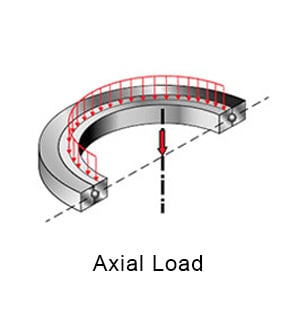Radial Vs Axial Load
Dive into the detailed analysis of radial vs axial load in our extensive guide. Knowledge of these bearing loads is critical for maximizing bearing efficiency and lifespan. Join us as we unravel the complexities of bearing loads!
Understanding Radial Load
What is Radial load?
Radial load is a force acting perpendicularly to the axis of a rotating shaft or component, directed towards its center. In bearings, it's the load carried at right angles to the rotation axis.
Examples of Radial Load Applications
Radial loads are typical in rotating applications such as car wheels, machine shafts, electric motors, and gearboxes. For example, a car's wheel bearings experience varying radial loads dependent on the vehicle's speed and weight.
How Radial Load is Transferred through the Bearing
In a bearing subjected to radial load, the load is transferred from the inner raceway, through the rolling elements (balls or rollers), to the outer raceway. The force is distributed over several rolling elements simultaneously, depending on the bearing design and the size of the load.

Impact of Radial Load Distribution on Rolling Elements
Radial load distribution impacts bearing performance and longevity. Proper distribution prevents over-stressing individual elements, ensuring balanced wear. However, uneven distribution can cause premature failure due to excessive stress on certain elements.
Suitable Bearing Types for Handling Radial Load
Various bearings handle radial loads, including deep groove ball bearings for their versatility, cylindrical roller bearings and needle roller bearings for heavy loads, and self-aligning ball bearings for misalignment scenarios. Each type is selected based on the application and load magnitude.
Understanding Axial Load
What is Axial Load?
Axial load, synonymous with thrust or parallel load, is the force that acts parallel to the shaft's axis. Simply put, it's a force that's exerted along the lines of the center, or axis, of an object.
Examples of Axial Load Applications
Axial loads are prevalent in several sectors, such as automotive axles, jet engines, wind turbines, and industrial conveyor systems. They also occur in pumps and compressors, and screw drive systems due to forces exerted by fluid, gas, or mechanical movement.
How Axial Load is Transferred through the Bearing
Axial load transfers through a bearing's raceways and rolling elements. In thrust ball bearings, the load passes from one washer to another via balls aligned parallel to the rotation axis, enabling high axial load capacity. Tapered roller bearings handle axial and radial loads, with their tapered design facilitating axial load transfer along inclined surfaces, thereby improving load distribution and reducing stress.

Balanced Load Distribution in Axial Load Scenarios
Achieving balanced load distribution in axial load scenarios is key for optimal bearing performance and longevity. Ideally, axial loads are equally shared among all rolling elements, minimizing wear and enhancing bearing efficiency. Factors like misalignment or uneven loading can disrupt this balance, increasing stress and potentially causing premature failure.
Suitable Bearing Types for Handling Axial Load
Thrust bearings are the go-to choice for handling axial loads due to their design that accommodates forces parallel to the axis. Types include thrust ball bearings for lighter loads and thrust roller bearings for heavier loads. Angular contact ball bearings can manage combined radial and axial loads, provided the axial component is significant.
Comparison of Radial Load and Axial Load
Differentiating between radial and axial loads, or understanding the concept of radial vs axial load, is vital for the optimal selection and use of bearings. The primary distinctions lie in the direction of the force applied - radial loads acting perpendicular to the shaft's axis, and axial loads acting parallel.
The type of bearing used also varies between these loads. While deep-groove ball bearings are better equipped to handle radial loads, thrust ball bearings are designed for axial loads. However, it's essential to note that most bearings, such as angular contact ball bearings, can handle both radial and axial loads.
For a more comprehensive understanding, let's look at a comparative table:
|
|
Radial Load |
Axial Load |
|
Force Direction |
Perpendicular to shaft's axis |
Parallel to shaft's axis |
|
Load Distribution |
Distributes force across the circumference of the bearing, |
Distributes force along the bearing's axis |
|
Bearing Examples |
Deep-groove ball bearings, cylindrical roller bearings, needle roller bearings |
Thrust ball bearings, tapered roller bearings |
|
Typical Applications |
Rotating Machinery, Wheels, Conveyor belts, electric motors, gearboxes, etc. |
Vertical shafts in transmissions, helicopters, Wind Turbines, etc. |
Practical Considerations
Assessing radial and axial loads in real-world applications demands attention to various aspects such as operating speed, load magnitude and direction, and the operating environment. The careful balancing of these loads can lead to a noticeable improvement in bearing performance and life.
A case study worth mentioning is in the realm of automotive wheel bearings. These bearings need to handle both radial loads (from the vehicle's weight) and axial loads (from cornering forces). The delicate balance and distribution of these loads are crucial for the smooth and efficient operation of the vehicle.
Additionally, the bearing's material selection, like Chrome Steel or Stainless Steel, also plays a significant role in handling radial and axial loads. Chrome Steel, for instance, is often used for its high load capacity and wear resistance, making it suitable for applications with high radial and axial loads.
Conclusion
Understanding and managing radial vs axial load can greatly enhance bearing performance and longevity. Selecting the right bearing, based on the load nature, can boost your machinery's efficiency.
At LILY Bearing, we provide a wide range of bearings to meet varied load needs. Our expertise and quality commitment assure optimal performance and extended machinery life through our tailored bearing solutions.
In the world of mechanical engineering, the interplay between radial and axial loads is a fascinating subject. Understanding these forces and their application in bearings is key to maximizing operational efficiency and longevity in your mechanical systems. In the 'radial vs axial load' debate, the correct answer is often a combination of both - all tailored to your unique needs.
Keep Learning








